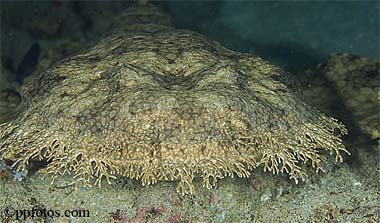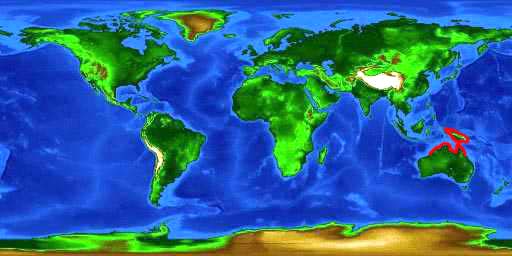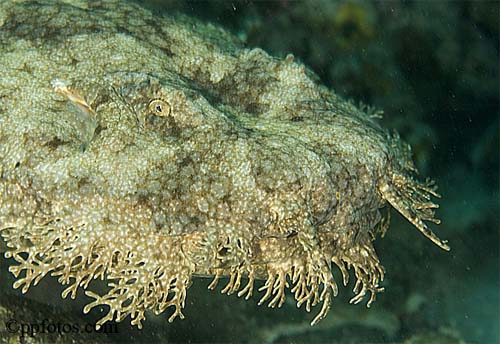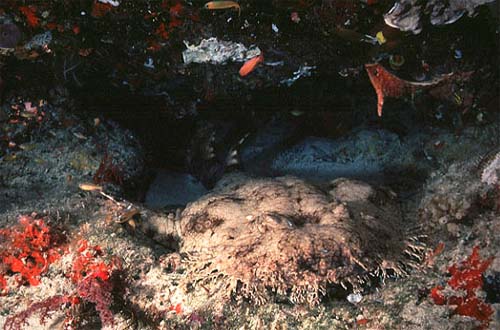
Eucrossorhinus dasypogon
This unusual carpet shark has a fringe along the front of its flat head, and an elaborate camouflage pattern, ideal for its ambush style of hunting. It usually grows to about 4 feet long, with broad, rounded pectoral fins, and a series of lobed fins back to its asymmetrical caudal fin. This nocturnal shark eats bony fish and some invertebrates that live at the reef floor, and has been known to mistakenly bite humans that don’t realize that they’ve wandered close. It’s popular with diving tourists and in public aquarium because of its unusual appearance.
Order: Orectolobiformes
Family: Orectolobidae
Genus: Eucrossorhinus
Species: dasypogon
Common Names
English language common names are tasselled wobbegong, bearded wobbegong, Ogilbys wobbegong, tassled wobbegong, and tasseled wobbegong. Other common names are dusket wobbegong (Danish), franjebakerhaai (Dutch), iga tao (Gela), requin tapis barbu (French), requin-tapis barbu (French), tapicero barbudo (Spanish), valkotäpläpartahai (Finnish), and wobbegong strapatý (Czech).
Importance to Humans
There is little known about the interest of fisheries for this species, however it is believed to be minimal. The tough and attractively colored skin is sometimes used for leather. The tasselled wobbegong is often maintained in aquaria in the United States as it makes a spectacular display animal.
Danger to Humans
The tasselled wobbegong may bit in self defense or if a human foot is mistaken for prey. However, divers often approach and photograph this species without incident.
Conservation
Although little is known about the tasselled wobbegong, its conservation status should be of concern due to its limited distribution range and habitat destruction from pollution and destructive fishing practices. Fortunately, the Great Barrier Reef Marine Park protects some of this wobbegong’s habitat. It is listed as “Near Threatened” by the World Conservation Union (IUCN). This is due to suspected population declines, which are predicted to continue in future years. The IUCN is a global union of states, governmental agencies, and non-governmental organizations in a partnership that assesses the conservation status of species.
> Check the status of the tasselled wobbegong at the IUCN website.
Geographical Distribution

The tasselled wobbegong is found in the western Pacific Ocean off eastern Indonesia (Waigeo, Aru), Papua New Guinea, and northern Australia including Barrow Island off Western Australia, northern Queensland, and the Northern Territory. It is often observed residing in the northern Great Barrier Reef off the coast of Australia. There has been a reported occurrence in waters off Malaysia, however this is considered questionable.
Habitat
This tropical shark lives at depths to 131 feet (40 m) on the continental shelf as well as on offshore reefs. It is present on inshore coral reefs as well as in reef channels and reef faces. It has been suggested that this species may be an obligate coral reef dweller. The tasselled wobbegong is nocturnal, leaving resting areas in caves and under ledges to feed at night.
Biology

Distinctive Features
The tasselled wobbegong is flattened and broad with a head that is slightly wider than its length from the tip of the snout to the fifth gill openings. The mouth is located in front of the eyes and there is symphysial groove on the chin. The underside of the chin has numerous highly branched dermal lobes. The 24 to 26 pairs of dermal lobes located on the sides and front of the head are highly branched and form a more-or-less continuous fringe from the tip of the snout to the pectoral fin bases. The nasal barbels are branched with complex multiple lobes.
The trunk of this wobbegong is quite broad. There are two spineless dorsal fins with a longer interspace than the first dorsal fin inner margin and slightly longer than half of the first dorsal fin base. The first dorsal fin height is about equal to the length of its base and its origin is opposite the posterior fourth of the pelvic fin bases. The pectoral fins and pelvic fins are broad. The origin of the anal fin is posterior to the second dorsal fin origin. The precaudal tail is short and the distance from the pelvic fin insertion to the origin of the lower caudal origin is approximately equal to the length of the head. The caudal fin has an upper lobe that is hardly elevated above the axis of the body and a strong terminal lobe and subterminal notch, however there is no ventral lobe.
Coloration
The body of the tasselled wobbegong has a reticulated pattern of narrow dark lines over a lighter background with large dark spots located at the junction of the lines.
Dentition
There are three rows of fang-like teeth located at the upper symphysis and two rows at the lower symphysis. The posterior teeth have strong medial cusps with lateral cusplets absent or variably present and the labial roots are weak. Tooth row count is 23-26/19.
Denticles
There are no enlarged tubercles on the body and head with the exception of those above the eyes.
Size, Age, and Growth
The maximum size of the tasselled wobbegong is believed to be 4 feet (1.25 m) total length although there was one report of a specimen that measured 12 feet (3.66 m) however this is considered to be uncertain and perhaps incorrect. At birth, the tassellated wobbegong is approximately 7.9 inches (20 cm) in length.

Food Habits
The tasselled wobbegong feeds on bottom fishes and perhaps benthic invertebrates. Nocturnal fishes that share their caves including squirrelfish, soldierfish, and sweepers are known prey items of the tasselled wobbegong. When unsuspecting fish comes within reach, the tasselled wobbegong pulls its jaws apart and literally sucks the prey into its mouth where the needle-like teeth pierce its flesh, giving no chance for escape.
Reproduction
The tasselled wobbegong is an ovoviviparous species meaning that the embryos feeding initially on yolk and eventually receiving additional nourishment from the mother through absorption of uterine fluid. This fluid is enriched with mucus, fat or protein and is secreted by specialized structures within the uterine wall. The tasselled wobbegong gives live birth to 20 or more pups with each newborn measuring approximately 7.9 inches (20 cm) in length.
Predators
Any large fish or marine mammals are potential predators of the tasselled wobbegong.
Parasites
There is little information available regarding the parasites of the tasselled wobbegong.
Taxonomy
Pieter Bleeker, a Dutch ichthyologist, originally described the tasselled wobbegong as Crossorhrinus dasypogon, in 1867. This name was later changed to the currently valid Eucrossorhinus dasypogon (Bleeker 1867). Synonyms used in past scientfic literature referring to this species include Orectolobus ogilbyi Regan 1909 and Orectolobus dasypogon Bleeker 1867.
Prepared by: Cathleen Bester